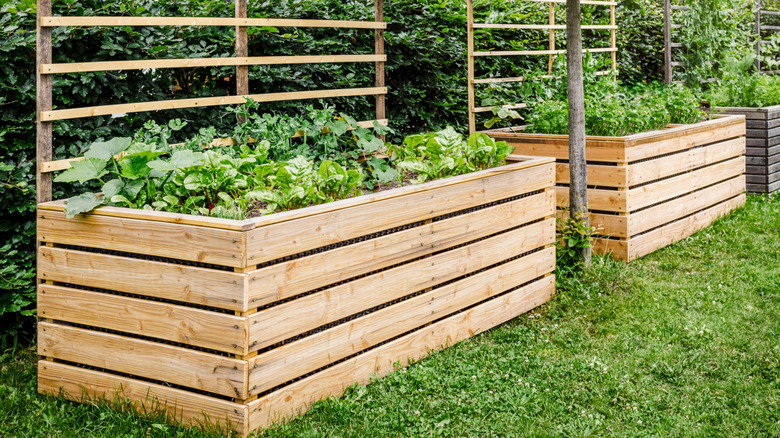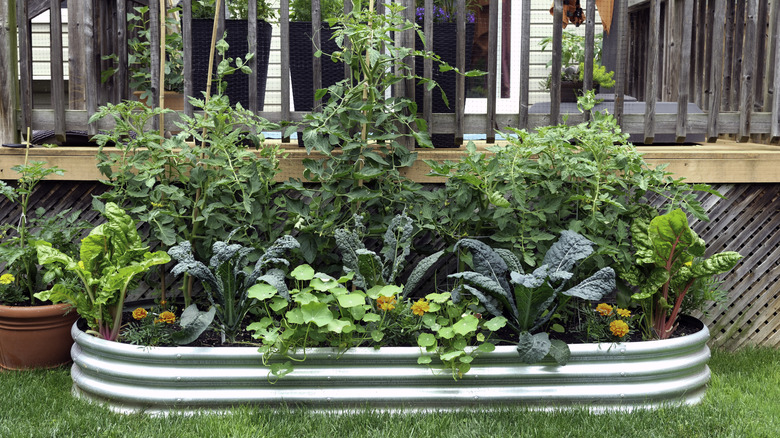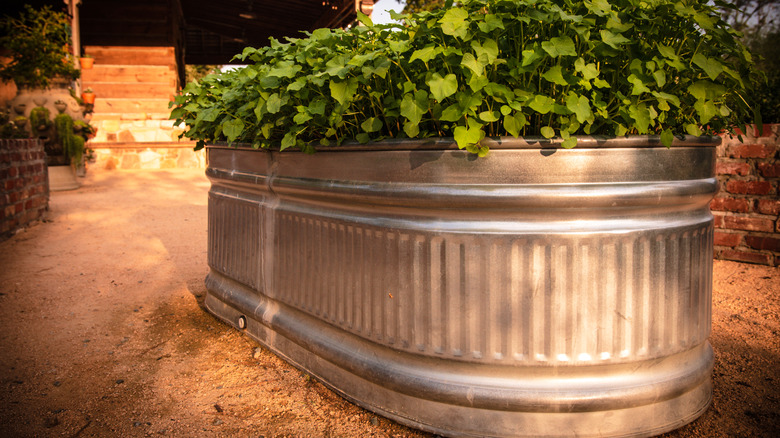Metal Vs Wood Raised Garden Beds: Which Should You Use?
We may receive a commission on purchases made from links.
There are plenty of reasons to forego traditional gardening and use raised garden beds for your planting needs and wants. They maximize space by utilizing vertical growing for a smaller footprint, they're phenomenal if you can't or don't want to get on your hands and knees, and they create tidy, organized spaces to facilitate the blending of gardening and aesthetics. But once you've decided to go the route of raised beds, what material should you use — wood or metal? Unless you're focused only on the visual appeal, there are some major factors to consider before choosing.
Factoring in just the aesthetic appeal, there are still plenty of options and designs to choose from for your raised garden beds. Wood beds can be made of dozens of different species, and metals have varying types and patinas to match your visual tastes. So, based strictly on the optics of your garden, you're sure to find just what you're looking for. But there are other things to take into consideration, such as price, safety, and durability.
The affordability of metal versus wood raised garden beds
Wood raised garden beds can be very cheap if you go for a species like pine. A 4-foot 2-by-4 piece of lumber is $3.04 at Lowe's, so it's affordable, easy to obtain, and easy to work with since it's a soft wood. It will last about three to five years if taken care of properly. A top-tier wood species like cedar is priced at around $18 for an 8-foot 2-by-4; however, it can be left unfinished (which means less maintenance), and can last around 10 to 15 years. But if the thought of building a raised bed from scratch makes you break out in a sweat, you can purchase a SoliWood raised bed for $50.
Metal sheets are quite pricey; however, metal bed kits are affordable and easy to put together. A prefab raised bed kit is a great way to DIY your garden without having to scour the yard for materials. These kits, such as the GooZoo galvanized raised garden bed kit, could last 20-plus years and cost around $25.
You can save money by DIYing your raised beds, especially if you have wood lying around from another project or a dilapidated item that can be repurposed. All you need is some thoughtful planning, tools, and patience. However, if you prefer a quicker, easier solution, a metal prefab kit will give you the most bang for your buck.
Which raised garden bed material is safer and more durable?
Pine, having the staying power of three to five years, breaks down at the quickest rate and needs to be treated or sealed in order to prevent quicker decaying and insect damage. Cedar, however, is rot and insect resistant, while also maintaining shape when temperature and humidity cause pine to warp and shrink. If you're leaning toward wood, you should be using cedar for your raised beds. As for safety, splinters and chemicals from treated wood are your main concerns — research chemicals in treated wood to make sure you're not adding toxicity to your garden, and tackle splinters by sanding and sealing the wood.
Generally, metal beds last 20-plus years, are pest and rot resistant, and require very little maintenance overall. Temperature and humidity play a minimal role in degrading the material, and do so at a much slower pace without causing warping or shrinking of the metal. It's important to note the soil in close contact to the sides of metal beds can heat up and dry out. So, keep that in mind and consider a DIY raised-bed watering system to keep plants hydrated in metal beds. When you consider safety, metal can get incredibly hot, and sharp edges are prevalent and dangerous. Find ways to protect yourself from the sharp edges with pool noodles, split garden hoses, or pipe insulation.


